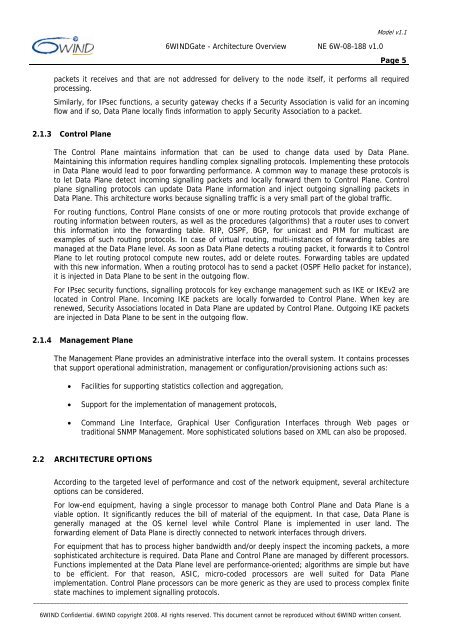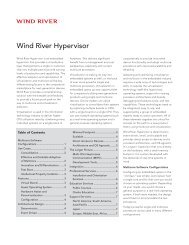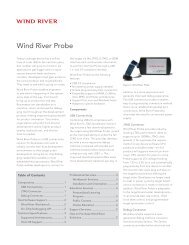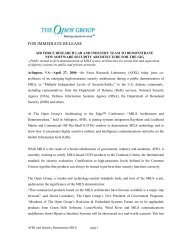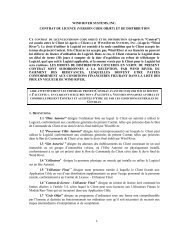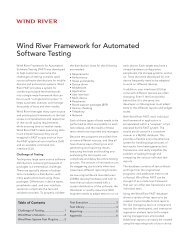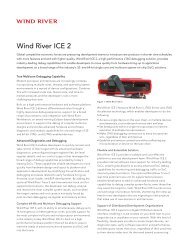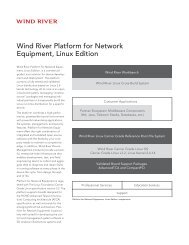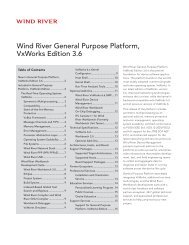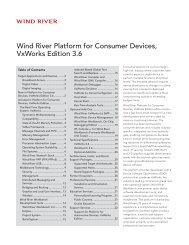6WINDGate™ - Architecture Overview - NE 6W-08-188 ... - Wind River
6WINDGate™ - Architecture Overview - NE 6W-08-188 ... - Wind River
6WINDGate™ - Architecture Overview - NE 6W-08-188 ... - Wind River
You also want an ePaper? Increase the reach of your titles
YUMPU automatically turns print PDFs into web optimized ePapers that Google loves.
<strong>6W</strong>INDGate - <strong>Architecture</strong> <strong>Overview</strong> <strong>NE</strong> <strong>6W</strong>-<strong>08</strong>-<strong>188</strong> v1.0<br />
Model v1.1<br />
Page 5<br />
packets it receives and that are not addressed for delivery to the node itself, it performs all required<br />
processing.<br />
Similarly, for IPsec functions, a security gateway checks if a Security Association is valid for an incoming<br />
flow and if so, Data Plane locally finds information to apply Security Association to a packet.<br />
2.1.3 Control Plane<br />
The Control Plane maintains information that can be used to change data used by Data Plane.<br />
Maintaining this information requires handling complex signalling protocols. Implementing these protocols<br />
in Data Plane would lead to poor forwarding performance. A common way to manage these protocols is<br />
to let Data Plane detect incoming signalling packets and locally forward them to Control Plane. Control<br />
plane signalling protocols can update Data Plane information and inject outgoing signalling packets in<br />
Data Plane. This architecture works because signalling traffic is a very small part of the global traffic.<br />
For routing functions, Control Plane consists of one or more routing protocols that provide exchange of<br />
routing information between routers, as well as the procedures (algorithms) that a router uses to convert<br />
this information into the forwarding table. RIP, OSPF, BGP, for unicast and PIM for multicast are<br />
examples of such routing protocols. In case of virtual routing, multi-instances of forwarding tables are<br />
managed at the Data Plane level. As soon as Data Plane detects a routing packet, it forwards it to Control<br />
Plane to let routing protocol compute new routes, add or delete routes. Forwarding tables are updated<br />
with this new information. When a routing protocol has to send a packet (OSPF Hello packet for instance),<br />
it is injected in Data Plane to be sent in the outgoing flow.<br />
For IPsec security functions, signalling protocols for key exchange management such as IKE or IKEv2 are<br />
located in Control Plane. Incoming IKE packets are locally forwarded to Control Plane. When key are<br />
renewed, Security Associations located in Data Plane are updated by Control Plane. Outgoing IKE packets<br />
are injected in Data Plane to be sent in the outgoing flow.<br />
2.1.4 Management Plane<br />
The Management Plane provides an administrative interface into the overall system. It contains processes<br />
that support operational administration, management or configuration/provisioning actions such as:<br />
• Facilities for supporting statistics collection and aggregation,<br />
• Support for the implementation of management protocols,<br />
• Command Line Interface, Graphical User Configuration Interfaces through Web pages or<br />
traditional SNMP Management. More sophisticated solutions based on XML can also be proposed.<br />
2.2 ARCHITECTURE OPTIONS<br />
According to the targeted level of performance and cost of the network equipment, several architecture<br />
options can be considered.<br />
For low-end equipment, having a single processor to manage both Control Plane and Data Plane is a<br />
viable option. It significantly reduces the bill of material of the equipment. In that case, Data Plane is<br />
generally managed at the OS kernel level while Control Plane is implemented in user land. The<br />
forwarding element of Data Plane is directly connected to network interfaces through drivers.<br />
For equipment that has to process higher bandwidth and/or deeply inspect the incoming packets, a more<br />
sophisticated architecture is required. Data Plane and Control Plane are managed by different processors.<br />
Functions implemented at the Data Plane level are performance-oriented; algorithms are simple but have<br />
to be efficient. For that reason, ASIC, micro-coded processors are well suited for Data Plane<br />
implementation. Control Plane processors can be more generic as they are used to process complex finite<br />
state machines to implement signalling protocols.<br />
_________________________________________________________________________________________________________________<br />
<strong>6W</strong>IND Confidential. <strong>6W</strong>IND copyright 20<strong>08</strong>. All rights reserved. This document cannot be reproduced without <strong>6W</strong>IND written consent.


